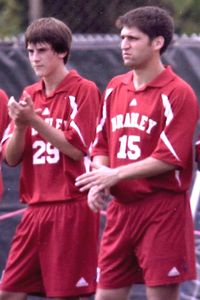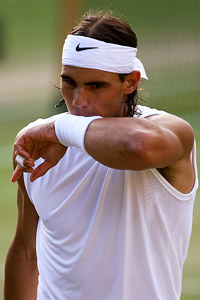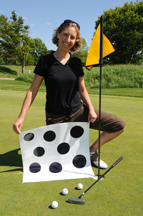PEORIA, Ill. -- A week before Bradley University soccer players were to report for the Fall 2007 season, midfielder Danny Dahlquist's family attended Mass at St. Mark's Catholic Church near the school. The church was the foundation of their family, and as Danny's mother, Tricia, left that Sunday morning, a woman approached her.
"She walked up to me and started shaking my hand, saying what a beautiful family we had," Tricia said. "I thought, 'Well, thank you.' As she was leaving, I realized she had slipped money in my hand. Apparently she had won it somewhere and felt the need to share, spread the wealth so to speak, and she said, 'Bring your family out to dinner.'"
The Dahlquists went home and called Danny, who was living in a house with teammates near campus. He joined his parents and six brothers and sisters at Corky's Ribs & BBQ. Danny quickly ate and, because he was born about a three hours' drive from Wrigley, wanted to watch the Cubs game. He picked up his baby sister, Ellen, and walked back and forth to the area in the restaurant where the game was on TV. Tricia still has that image burned in her mind.
"That's my last vision of him," she said, "standing there with his sister in his hand."
It was the last time the family was together.
COLLEGE PRANK GONE WRONG
It was Saturday, Aug. 11, 2007, and the Bradley soccer friends and teammates living at 2008 West Laura Ave. had decided to throw a party. Danny had moved in for his sophomore year, opting to live off campus instead of in the dorms where he'd lived as a freshman on the team.
Living the life of a Bradley soccer player was a dream for Dahlquist. As he grew up across the street from Bradley, a private school with about 6,000 students, he'd become a devout Braves soccer fan. When he was 10, he met Bradley soccer coach Jim DeRose at a soccer camp. It would be an achievement for a local kid to make Bradley's team. Danny told his parents he'd rather practice for four years at Bradley, a Division I school, than go somewhere else and play for a Division III school. He loved the university where his parents work -- Tricia as an English instructor and Craig as the senior associate athletic director.

Courtesy Dahlquist family
Danny's parents, Craig and Tricia, work at Bradley and settled the family in a home near the campus.
But on this night, the teammates and roommates were going to party. They got some alcohol -- later found to be obtained by one of the players, Nick Mentgen, -- and invited some friends. Later that night, the housemates wanted to play a prank on a few of their roommates. According to various reports, Dahlquist and the others had done this before: lighting fireworks, including bottle rockets, Black Cats Fireworks and Roman candles, under one another's bedroom doors. So when Dahlquist and another housemate went to their rooms to go to bed, they were prepared.
"Danny, anticipating that I think from the previous night or two, shoved some towels underneath the door to keep that from happening or to keep the door from being opened or to keep the Roman candles out," said Kevin Lyons, Peoria County's state's attorney.
Based on police interviews, court documents and a report from Lyons, this is what happened:
Dahlquist's roommates -- Bradley soccer players Mentgen, David Crady and Ryan Johnson and a fourth friend, Daniel Cox -- lit Roman candles and shoved them under Dahlquist's bedroom door on the second floor of the house. Each was involved in the incident through obtaining the fireworks, lighting them or placing them under the door. After one didn't go off, likely because the opening under the door was blocked, one of the men used a coat hanger to remove the blockage and at least one more Roman candle was shot under the door.
"The flames … were about 1,500 to 1,800 degrees in temperature Fahrenheit," Lyons said. "The flames went across the room. There was a futon across the room and these balls shooting across the floor would hit the wall [and] burst into a bigger flame. The second time when they ran down the stairs and outside, there was no Danny Dahlquist, no nothing."
Dahlquist's bedroom was on fire. After his teammates saw a glow in the second-story window, they went back into the house but couldn't rescue their friend because of the smoke and heat. They woke another roommate, sophomore midfielder Travis English, who was asleep in his own room, and got out of the house. At 4:34 a.m., Gina Goett, a friend invited to the party by Mentgen and Johnson, dialed 911. It was a chaotic scene, with sirens, police, smoke and fire. Johnson fled.
Mentgen was helped up to a secondary roof as he was trying to help get his friend out. In a police interview, an emotional Mentgen described the scene: "I hear Danny, so I know that he is conscious, but he can't see me and I can't see him … I just hear him saying … he is not making words out … I can hear him not yell, but ahhh-ahhh … nothing like 'Hey, help!' Nothing like that. I don't think he even knew what was going on."
Firefighters found Dahlquist on the floor near a window in his room. He was rushed to the hospital but pronounced dead at 5:09 a.m. on Sunday, Aug. 12, from "asphyxiation due to smoke inhalation."
PEORIA-BORN AND BRED
Growing up in this blue-collar city of about 100,000 in north-central Illinois, Dahlquist attended Notre Dame High School a few miles from his home. His name is engraved at the school on a plaque celebrating the 2004 Class A state soccer championship.

Courtesy Bradley University
Dahlquist's former teammate and roommate, Nick Mentgen, right, tried to save Danny from the burning house.
The 5-foot-9, 145-pound Dahlquist wasn't a superior athlete, but he wanted to play at Bradley so badly that a close friend likened him to the famed Rudy Ruettiger, who inspired the 1993 film "Rudy," about a former Notre Dame football player.
"It was everything to him," his father, Craig, said. "This community gave him an opportunity to not just be friends with those at Notre Dame, and not just be friends with those in the neighborhood, but becoming friends with everybody around this 10- to 15-mile radius. They all came together to play soccer."
Dahlquist enrolled at Bradley in the fall of 2006, made the soccer team as a freshman midfielder and was redshirted. The Braves went 8-8-4 that season, narrowly missing the NCAA tournament in a loss at home to Creighton in the Missouri Valley Conference championship.
The next season, Dahlquist was determined to be an integral part of the team. Teammates and Coach DeRose noticed Dahlquist practicing harder and improving. He'd moved into an off-campus house with Mentgen, Johnson, Crady and English.
Dahlquist was growing up, becoming more independent.
LOSING A SON AND A TEAMMATE
The Dahlquists were just waking up when the call came around 6:45 a.m.
Craig and Tricia Dahlquist had worked up a good speech for their son about underage drinking, but emergency-room personnel immediately took them to a room where one of the nuns at OSF Saint Francis Medical Center told them what happened. They asked if they could see him. She said no. Danny had died.
Jailed
 Nick Mentgen
Nick Mentgen
Hometown: Peoria, Ill.
High School: Notre Dame
Age: 23
Bradley soccer forward, 2004 to 2006
Business major; marketing
Bradley Athletic Director's Honor Roll: Fall 2006
Enrolled as a senior when he pleaded guilty to involuntary manslaughter.
Release date: July 18, 2008
 Ryan Johnson
Ryan Johnson
Hometown: Morton, Ill.
High School: Morton Community H.S.
Age: 22
Bradley soccer forward/midfielder, 2004 to 2006
Bradley soccer's Most Improved Player: 2005
Communications major; public relations
Bradley Athletic Director's Honor Roll: Fall 2005 and Spring 2006
Enrolled as a senior when he pleaded guilty to involuntary manslaughter.
Release date: July 19, 2008
 David Crady
David Crady
Hometown: Metamora, Ill.
High School: Metamora H.S.
Age: 20
Enrolled in Bradley's award-winning Academic Exploration Program
Bradley soccer midfielder, 2006
Bradley Athletic Director's Honor Roll: Fall 2006, Spring 2007
MVC Honor Roll: 2007
Enrolled as a sophomore when he pleaded guilty to involuntary manslaughter.
Release date: July 17, 2008
 Daniel Cox
Daniel Cox
High School: Metamora H.S.
Age: 21
Enrolled as a sophomore at Illinois Central College when he pleaded guilty to involuntary manslaughter.
Release date: July 17, 2008
"It is a feeling like the life's sucked out of you. … I just remember saying, 'How could that be?' Stunned. It was just like the world stopped … as it did."
Craig sat on his front porch for hours that day. People came to see him and the family. It was a long day, but it was amazing to see such an outpouring. Colleagues, athletic department officials, the newly appointed university president and members of the soccer team stopped by to console the family.
On Aug. 13, the day after Dahlquist died, Mentgen, Crady, Johnson and Cox were charged. They each faced multiple counts of arson, including a felony that carried a sentence of up to 30 years in prison. Still, on the day of the funeral at St. Mark's, the Dahlquists say, Crady gave a heartfelt eulogy.
Not long after charges were filed, Johnson quit the team; Crady and Mentgen were dismissed. They continued to attend the school, but university president Joanne Glasser decided that playing sports at Bradley was a "privilege that they had forfeited." She also decided Bradley would have a soccer season in 2007.
INSPIRATION, NOT MOTIVATION
The season started 19 days after Dahlquist's death. A logo memorializing him was painted on the home field. A flag with his number was raised for home games. "Once a Brave, always a Brave" was printed on team jerseys.
During the season, the three accused students attended games, called former teammates to root for them and exchanged text messages with DeRose. Bradley senior goaltender Mike Haynes said it was like they were still part of the team.
Sophomore midfielder Chris Cutshaw said he would see Crady, Mentgen and Johnson at times in the stands and "just get lost."
"It was really hard not to think about it every game," Cutshaw said. "Even in moments of huge games you would just be taken to a different place and you would realize what this team has been through, and you would lose five minutes of the game. … They are still our friends."
Bradley reached the MVC title game again in 2007, again facing Creighton. Bradley senior Stephen Brust scored a late goal to win it 1-0 and give Bradley its first MVC tournament title. The team was going to the NCAA tournament for the fourth time, and players celebrated as they had all season -- hugging Craig Dahlquist on the field.

Courtesy the Dahlquist family
Danny played soccer for Notre Dame High School, which won the 2004 Illinois Class A state soccer championship.
The Braves had never won an NCAA tournament game. This was the beginning of a historic run.
Bradley beat DePaul at home in the first round of the NCAA tournament. The Braves went to Indiana and won on penalty kicks. They went to Maryland, where they trailed 2-0 with less than three minutes to play. Bradley scored two goals, including the tying goal with 37 seconds to play, sending the game to overtime. The Braves then scored in the second overtime with slightly more than a minute remaining on a header by Cutshaw.
Craig Dahlquist had difficulty finding the words.
"You felt it," he said. "You really did, all the way through."
It was on to the Elite Eight to face Ohio State on a cold, rainy December day. After a scoreless first half, the Buckeyes took control. It wasn't long before they led 4-0 and the realization poured down. The Braves' run was over. But you couldn't tell from the crowd, which started chanting, "BU, BU, BU! We are the Braves, the mighty mighty Braves!"
The Dahlquists were there. Craig hugged each player.
"I felt proud," Tricia said. "I felt joy. I felt the Bradley pride. It was great to see Bradley accomplishing what they were accomplishing; given the circumstances or not, it was a great accomplishment."
ONCE A BRAVE, NOT ALWAYS A BRAVE
On Jan. 23, 2008, six weeks after the end of the season, all four men, facing a minimum six years if convicted, agreed to plead guilty to a lesser felony, involuntary manslaughter, and spend six months in the Peoria County Jail. Lyons, who had said he didn't want to turn one tragedy into four others, spoke publicly after the hearing.
Dahlquist memorial
Bradley started a memorial fund in Dahlquist's name. The school has raised more than $30,000 through sales of bracelets, Elite Eight T-shirts, an online jersey auction, the postseason banquet, other contributions in his honor and charity auctions to create an endowed scholarship in Dahlquist's name.
Dahlquist's No. 29 has not officially been retired, but several people say you won't see it worn anytime soon. Dahlquist never played in a game for Bradley, but as the Braves open the 2008 soccer season, his picture is still prominent on the
school's athletic Web site, and the flag raised in his honor will wave again. And his locker remains untouched.
"As the death of Danny Dahlquist is permanent, so shall the lifetime felony convictions of the defendants be permanent," Lyons said.
The plea agreement required the four to also serve two years' probation and pay a total of more than $20,000 to the Dahlquist family for funeral, burial and destroyed property.
The Dahlquists did not take sides or say what they thought should happen to Danny's friends. Instead, they offered support to the families of the jailed students.
"I feel great compassion for the families," Tricia said. "They are going through suffering themselves on many different levels, some of which we'll never fully understand, and so I have nothing but sympathy for them and compassion, and truly they need prayers as much as anybody."
In April, Bradley informed Mentgen, Crady and Johnson they could not return to the university because they had violated school code, according to a report in the Peoria Journal Star. Ronald Mentgen, the father of Nick, said his family felt "betrayed." Randy Crady, a Bradley alumnus and father of David, said, "I am embarrassed to say how my alma mater is treating these young men who need support."
In a statement this week to ESPN, Glasser said: "The Dahlquist tragedy has deeply affected every member of the campus community. I feel tremendous compassion and sadness for all those involved in that terrible incident. Having said that, the University has policies and procedures in place. We have followed them. There has been a series of written communications that have been sent to all parties affected by this tragedy. Because of privacy laws covering our students, we are unable to discuss with more specificity the events and subsequent actions that have taken place. "
ESPN.com tried on numerous occasions to contact the families and attorneys of the former Bradley students convicted of involuntary manslaughter in connection with Dahlquist's death, but they declined to comment. The men are scheduled to be released by July 19.
MOVING FORWARD

ESPN
Craig and Tricia Dahlquist and their 2-year-old daughter, Ellen, visit Danny Dahlquist's grave at St. Mary's Cemetery in West Peoria, Ill. Dahlquist died last August in a college prank gone wrong.
Like a painting, the vast open area in St. Mary's Cemetery is secluded from the noise of Bradley University. Birds sing and trees dance in a light breeze. There is peace here, but not closure.
A van pulls up. Craig and Tricia get out with their 2-year-old daughter, Ellen, and walk over to a new headstone. Sometimes they cry on visits like this, but not on this January day.
"I think a lot of people can see themselves in our shoes …" Tricia said. "These are just parents who lost a child in a tragic accident. Kids going off to college all the time, and you just hope and pray that nothing like this happens … and yet, it did."
There's a soccer ball, a pair of soccer cleats and goalkeeper gloves and flowers by the grave. The stone reads, "Be not afraid, I go before you." Craig kneels and gently wipes the name of his son … Sheridan "Danny" Dahlquist.
Danny was 19.
Ben Houser is a feature producer for ESPN.
Original here









 Nick Mentgen
Nick Mentgen Ryan Johnson
Ryan Johnson David Crady
David Crady Daniel Cox
Daniel Cox









